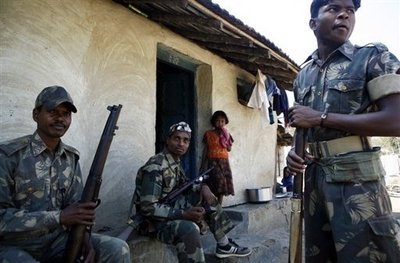India’s Forgotten War Intensifies
 First, my apologies for being relatively erratic with updates. I’m in the process of re-locating to Ottawa and just haven’t had time to do much with India’s Forgotten War. All of this is unfortunate timing on my part, because recent developments in the Maoist insurgency suggest that we may be witnessing not only the intensification of the war, but an evolution in its nature. The Naxalites have never presented as much of a threat to the stability of the state as they do now.
First, my apologies for being relatively erratic with updates. I’m in the process of re-locating to Ottawa and just haven’t had time to do much with India’s Forgotten War. All of this is unfortunate timing on my part, because recent developments in the Maoist insurgency suggest that we may be witnessing not only the intensification of the war, but an evolution in its nature. The Naxalites have never presented as much of a threat to the stability of the state as they do now.
In the past month, the Naxalites have flexed their muscles and declared a ‘Liberated Zone’ in West Bengal. While government forces have re-established nominal control over Lalgarh, they have failed to inflict significant casualties on the Maoists who, having made their point, have simply melted back into the jungle.
This was followed last week by a major attack which killed at least 30 CRPF personnel (a number are still missing and unaccounted for). The attack was significant because not only was it a well co-ordinated, twin ambush, but the it occured near to Chattisgarh’s capital, Ranchi Raipur (thanks to Rahul for catching my mistake).
Additionally, last week, PTI reported that:
An inter-state Maoist arms racket has been busted with the arrest of a businessman in the national capital and his counterpart in Jharkhand with recovery of a huge cache of bulletproof jackets and sophisticated gadgets.
While the existence of nascent urban Maoist cells is not news to anyone who has followed the growing tentacles of Naxalism in India, the arrests have made explicit the complex logistics and ideological networks which exist across the entire country. Revolutionary Maoism is not only a rural phenomenon that affects the poorest and most backward districts of the country. It is a national movement dedicated to the overthrow of India’s current system of government.
Finally, demonstrating the new confidence of the Naxalites and perhaps signalling a shift in tactics, a spokesperson for the CPI (Maoist) has threatened to:
[R]esort to LTTE-style attacks against Congress President Sonia Gandhi and Prime Minister Manmohan Singh... A threat has also been issued against Union Home Minister P Chidambaram, the release said and asked all Congress legislators, both from Parliament and assembly, to quit within a week or face “death warrants”.
What has the government response been? As mentioned in a previous post, Delhi has now formally proscribed the CPI (Maoist) and a number of affiliated groups as ‘terrorists’. Beyond that, there are unconfirmed reports that the government is planning a major, co-ordinated counter-insurgency campaign in the most badly affected districts this September. I hope to have more on this soon.
In the meantime, not much seems to have changed. The Naxalites are branching out tactically and territorially. They seem to have calculated that they are now in a position to intensify their insurgency. And, so far, the government has not seemed fit to meet this threat.
(Image: Manpreet Romana/AFP)
Very clear thoughts ! Its nice to read updated information. There is correction needed in the name of capital of Chhattisgarh which is Raipur. Ranchi is the Capital of Jharkhand. I live in Chhattisgarh and there has been two major attacks within 15 days. It seem that naxalites are showing rage over ban of CPI(M). It is also true that State Police is not well equipped with the latest weapons and also not expert in guerilla war tactics. Problem can only be solved by special armed forces. Also it seems lack of coordination between state and central government. They should come forward for joint operation to tackle terrorism.
Rahul
July 28, 2009 at 9:27 am
Rahul,
I agree with your points (and thanks for pointing out my mistake… I should have caught it myself), although I think that the ban on the CPI(Maoist) won’t make much of a difference to the Maoist’s ability to wage a war against the state. It’s more of a token gesture by the government.
States like Chhattisgarh are clearly poorly equipped to tackle the insurgency alone. Now that the Naxalites are getting bolder, maybe we’ll start seeing more co-operation between the various levels of government.
Michael
July 28, 2009 at 11:12 am
What can be expected till first causes of insurgency are eradicated? It’s too late for a stability orientation suggesting that the proper CI recipe will ‘deal with the problem’. In all affected states, Naxalites reflect conditions in place for the better part of a century. Through the last decade, assorted meetings of chief ministers of AP, CH, OR, JH, BI, WB, MA have failed to determine constructive approaches as the meetings were not intended to do so. Flattening cadres is a stopgap and, no, police are no longer up to the task, some forces and operations having contributed amply to aggravating dissent, over years. Once again, the only hope involves IAF involvement and a questionable aftermath given the unwillingness of ample Indians to see the fundamental problem.
msmills
August 8, 2009 at 1:58 am